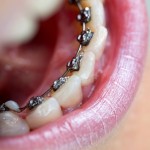
Interproximal enamel reductiontechniques have been used to address tooth shape and relieve mild to moderate crowding. First reported about 80 years ago interproximal enamel reduction (IPR) can undertaken using manual abrasive strips, mechanical oscillating abrasive strips, diamond-coated segmented discs, or rotating diamond burs. IPR may have adverse effects including tooth sensitivity and increasing susceptibility to caries so is considered controversial.
The aim of the review was to evaluate the available evidence from clinical studies on the effects of interproximal enamel reduction procedures used in orthodontics.
Methods
Searches were conducted in the Medline/PubMed, Google Scholar, Scopus, Web of science, Dentistry & Oral Sciences Source, ScienceDirect and Clinical Trails.gov databases. Randomised clinical trials (RCTs), non-randomized clinical trials (nRCT)and observational studies with a control group reporting the effects of IPR for orthodontic purposes on the teeth and periodontium were considered. Two reviewers independently selected studies and extracted data with risk-of-bias being assessed with the Newcastle-Ottawa scale (NOS) for observational studies and the Cochrane Risk of Bias (RoB 2) for RCTs. Outcomes included dental caries, chemical composition of enamel, enamel roughness, dental sensitivity, periodontal changes, crowding evaluation in the long term, changes in the skeletal profile, changes in the dental arches and orthodontic treatment duration. A narrative summary was presented because of the heterogeneity of the IPR procedures and outcomes.
Results
- 10 studies (5 observational studies, 4 RCTs, 1nRCT) involving a total of 274 patients were included.
- The overall quality of the studies was rates as low to very low.
- 5 studies reported no caries with IPR, 2 studies no enamel demineralisation and single studies no dentine sensitivity or periodontal changes.
- 1 study reported a reduction in treatment duration with IPR.
Conclusions
The authors concluded: –
There is insufficient research from observational studies and clinical trials available regarding IPR procedures.
Comments
The reviewers have searched several relevant databases. Only a small number of small studies met the inclusion criteria. The data from the included studies is succinctly summarised as heterogeneity in the studies and outcomes assessed means that meta-analysis was not possible. The overall quality of the available evidence was assessed as very low or low quality so while the available evidence suggests no adverse effects the findings should be interpreted with caution. Previously we looked at an earlier review by Koretsi et al (Dental Elf – 7th Oct 2013) which similarly identified only a small number of small studies addresses the effectiveness and adverse effects from IPR. Future studies need to be well conducted and reported and of appropriate size and duration and following international guidelines such as SPIRT and CONSORT statements and report using a common outcome set (COMET Initiative) and include patient relevant outcomes.
Links
Primary Paper
Gómez-Aguirre JN, Argueta-Figueroa L, Castro-Gutiérrez MEM, Torres-Rosas R. Effects of interproximal enamel reduction techniques used for orthodontics: A systematic review. Orthod Craniofac Res. 2021 Dec 5. doi: 10.1111/ocr.12555. Epub ahead of print. PMID: 34865310.
Other references
Dental Elf – 7th Oct 2013
Evidence on the adverse effects of interproximal dental stripping is limited
